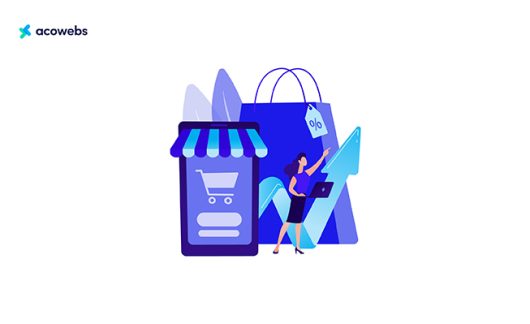Table of Contents
Customer journeys are the collection of your customers’ interactions with your brand. They are visual representations of how customers get from point A to point Z.
These visuals are also the foundation for providing the best possible customer experiences.
A journey map visually represents the entire journey your customers go through when engaging with your brand, from their first interaction with your product to their final purchase.
For businesses to succeed, they need to know what their customers really want. Customer journey mapping is one of the tools that can help achieve that goal.
In this post, we’ll go over how to create a customer journey map for your brand, as well as how to analyze and use it efficiently.
What is a Customer Journey Map?
A customer journey map is a visual representation of every interaction your consumer makes with your service, brand, or product.
Creating a journey map places you directly in the customer’s mind. It shows you where you may be underperforming, what you are doing right, and what areas to improve throughout the customer experience.
A journey map shows the various touchpoints that your customer might have with your brand.
It breaks down the actions they took to complete an objective. It shows how they interacted with the various elements of your brand.
These maps can take multiple forms, including illustrations, infographics, and also diagrams.
Below is a simple example of a B2B customer journey map that focuses on the emotions and common questions that a customer experiences along their trip.

ALSO READ: eCommerce Customer Segmentation Strategies to Increase Your Sales
Benefits of Customer Journey Mapping
Customer journey mapping provides you with a lens through which to view the world through the eyes of your target audience. There is no better method to promote your brand than to put yourself in their shoes.
How simple is it for customers to get in touch with your business? How long do they have to wait before they get the help they require? Is the content they’re viewing relevant to them?
Customers expect their experience with brands to be seamless and connected. They expect companies to know who they are and what they’re looking for without having to repeat or define their needs.
In this article, we will look at the several benefits of customer journey mapping and how such maps lay the groundwork for delivering contextual, tailored experiences.
Here are some of the benefits of creating customer journey maps:
Takes Your Teams Out of Silos
Without a common goal and processes, different departments within an organization can operate in isolation.
Because some departments outperform others, this organizational dispersion can lead to fragmentation in the customer experience.
In circumstances where most departments lack accurate client profiles, this will be detrimental to the business.
Having a customer journey map, on the other hand, might serve as a guiding principle for many departments to work with.
Every department will be responsible for improving the customer experience.
Through blended engagements, they’ll provide information and advice on how to accomplish this and tips on how to construct stronger customer personas.
Improves Your Customer Retention Rate
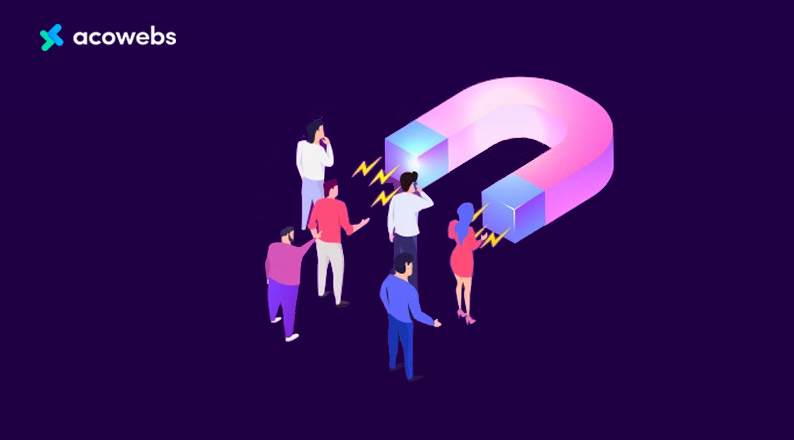
A well-designed customer journey map helps you identify the reasons why customers leave your brand for competitors.
And once you know this, you can work on improving your weaknesses as well as your strengths to ensure your company outperforms its competitors in the long run.
As a result, customers will encounter fewer pain points, and fewer people will abandon your brand in favor of competitors.
ALSO READ: How eCommerce businesses can turn organic traffic into valuable leads
Identifies Customer Pain Points
Through customer journey mapping, you can identify the various steps a customer goes through and the kind of actions taken during their online buying process.
Customer journey mapping can also help identify how your customers feel and the kind of questions they might have.
This information can help you determine what you should truly address on your website.
At the end of the day, you end up boosting customer experiences by learning how to communicate with them pleasantly and engagingly during their online buying experience.
Enhances Your Marketing Efforts
A customer journey mapping will aid in the development of a customer-centric mindset within your brand.
You can better cater to your clients if you understand how they interact with your brand.
You can set your sales and marketing objectives based on customers’ needs.
Facilitates Inbound Marketing
Instead of trying to find your consumers through outbound marketing, you may have your customers find you with inbound marketing.
In today’s world, inbound marketing is the most comprehensive strategy to attract customers, focusing on content, branding, social media, and Search Engine Optimization. You’ll be able to contact your buyers where they are if you map out how they connect with you.
ALSO READ: Tips to use content marketing for eCommerce sales
Building Your Map
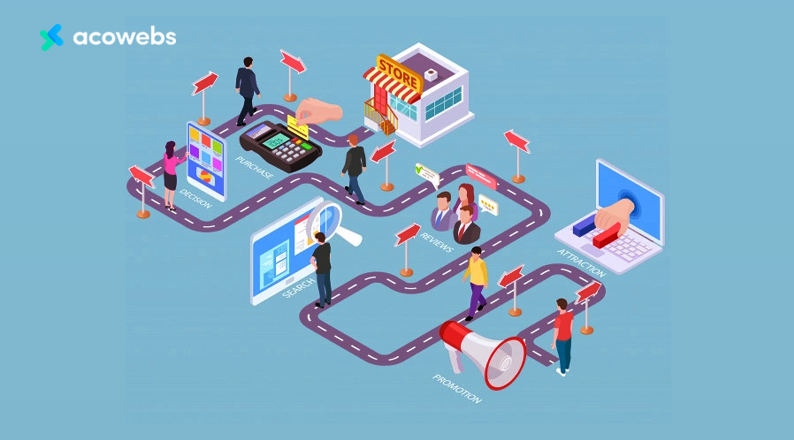
At this point, you now understand what a customer journey map is and why you should create one.
How then do you go about mapping your customer journey?
Customer journey maps can grow confusing if they are not kept focused. Although you can target several personas, investigate and visualize one persona and one client situation at a time.
Here are a few tips to follow in order to create a comprehensive customer journey map.
Set Specific Goals For The Map
It will be hard to ascertain whether your customer journey map will have a tangible impact on your consumers and your brand without a goal.
You will almost certainly need to identify existing and potential buyers so that you can create specific goals for those audiences at each point of their journey.
You can gather the main stakeholder groups within your company to set a goal and map out a strategy for improving the customer experience. Doing so helps gather valuable insight and helps set a logical and achievable goal.
Create Customer Personas
When creating your map, it’s a good idea to have at least one customer persona in mind.
Customer personas enable brands to comprehend homogeneous groups better and discover important qualities within them.
They concentrate on analyzing real customers, resulting in a more in-depth understanding of how your customers think.
To create buyer personas, undertake research and, most importantly, talk to your customers.
Collect data in whatever method you can think of, from customer interviews to questionnaires to user testing.
You’ll need information from real people, whether they’ve purchased from you or intend to do so.
ALSO READ: eCommerce Customer Surveys
Create a List of Buyer Touchpoints

The majority of your customer journey map is made up of consumer touchpoints. They are the means through which clients interact with your brand.
When conducting research and mapping out your touchpoints, make sure to include information on parts of the action, emotions & motivations, and the pain points.
The number and types of touchpoints on your customer journey map will vary depending on your brand. Select the touchpoints that best reflect a customer’s experience with your brand.
You can make this task easier by considering all of the possible ways your customer may come across your brand online.
Some of the most common touchpoints:
- Your brand website. Your website may be the primary point of contact between you and your clients.
- Social channels. The social media channels, maybe the second most essential touchpoint, allow customers to communicate with your brand directly.
- Paid ads.
- Email marketing, which includes newsletters.
- Third-party review sites. Perform a simple Google search on your brand to check which pages mention your brand. Verify these pages in Google Analytics to understand better where your traffic might be coming from.
Go a little deeper into each of the touchpoints you’ve recognized
Actions
Make a list of all the actions your buyers take during their encounters with your brand. Now that you know where clients connect with your brand, you can concentrate on how they do it.
Collect as much information as possible; you may end up with a lengthy list, but you can always justify your data in the end.
Data collection will assist you in determining whether buyers are doing too many activities in one or more stages of their journey.
Emotions & Motivations
Determine what your buyers are feeling emotionally at each stage. Every single action listed above is motivated by a specific emotion.
The emotional journey of your buyers will differ depending on the action they take. Knowing this can help you give the right content at the appropriate time, thereby easing the customer’s emotional journey through your brand.
Pain Points
Learn what obstacles are preventing your customer from taking the desired action. These are the roadblocks that your consumers confront along the way. They are commonly referred to as pain points.
Your customers may, for example, adore your goods but depart after discovering unexpectedly hefty delivery costs.
One solution is to establish a FAQ page that addresses frequently asked questions concerning shipping charges.
ALSO READ: Ways To Send Effective eCommerce Order Confirmation Emails
Decide on a Type of Customer Journey Map
There are various methods for documenting your prospects’ or current customers’ processes.
Because you’re building a map from a new perspective, you can select the appropriate map depending on your desired goals. Let’s take a quick look at four different types of customer journey maps.
Current State Journey Map
Current state journey maps are the most typically used maps, as they investigate how your consumer journey currently appears. These maps show you what your visitors are currently experiencing when interacting with your site.
Current state maps are excellent for identifying weak points at various phases and resolving current concerns.
Below is an example of a current state journey map. Each stage of the customer journey has been divided into different activities.
This degree of detail allows the creators to discover areas for improvement, such as unifying the domains grants.gov and benefits.gov, to optimize the customer experience.
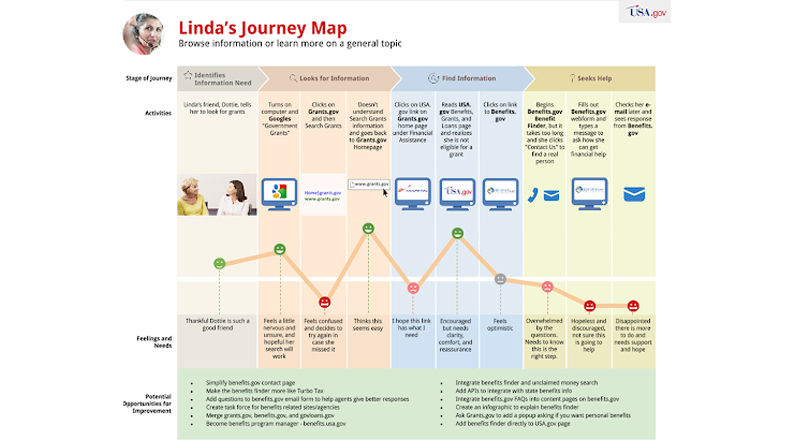
Day in the Life Journey Map
Day in the life journey maps visualizes the actions and emotions that your consumers are currently experiencing in their daily activities.
The actions do not necessarily involve your brand, but still, they do assist you in getting inside your customers’ heads.
The day in the life journey maps are most effective when utilized to meet unmet client needs before the customers are even aware that they exist.
When investigating new market development tactics, your organization may employ this form of the customer journey map.
Below is an excellent example of a regular day in the life of a dyslexic child. This map visualizes the customer’s day and the days of the individuals with whom they interact. The customer, in this case, is the child.
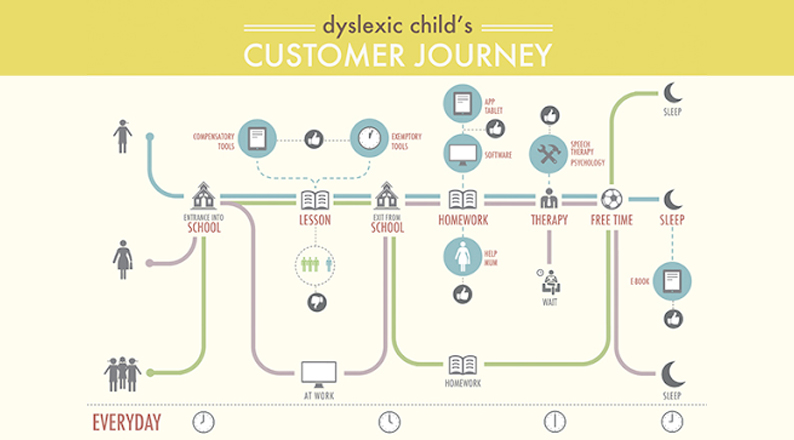
Future State Journey Map
The future state journey map visualizes customers’ actions, thoughts, and emotions during the future interactions with your brand.
You’ll need a current map to make the future state journey map because it’ll be based on current things.
The future state map is ideal for setting objectives and visualizing how things will be better after changing the existing state.
In the following example of a future B2B journey map, the brand uses it to visualize t exactly how they want their customer map to appear, including touchpoints, devices, and environments.
The future customer journey was created to represent the company’s goals in an easy-to-follow format for all departments. With this in mind, everyone may contribute to a similar objective in their unique way.
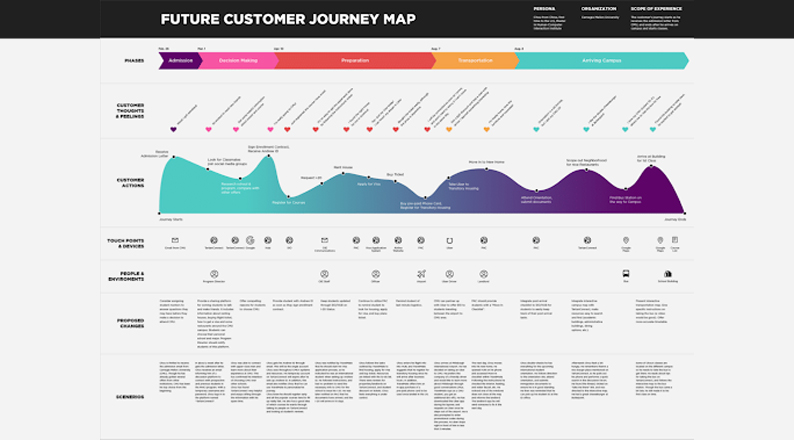
Service Blueprint Journey Map
The service blueprint journey maps are created with a simplified version of the map styles mentioned above.
They add the variables in charge of delivering that experience, such as workers, policies, technologies, and processes.
The best time to use a service blueprint journey map is to identify what needs to be done in the future to reach a specific customer journey.
Below is a simple example of a restaurant service blueprint map demonstrating the behind-the-scenes actions and processes required to enable a successful client journey.
In the restaurant scenario below, you could have various processes for takeaway meals vs a dining-in experience. In any case, a consistent and seamless experience is critical for customers.
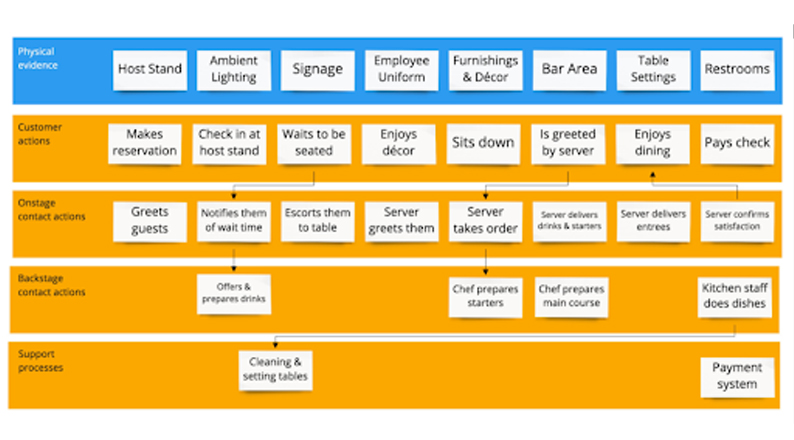
Examine Your Customer Journey
Just because you’ve finished designing your map doesn’t mean your work is completed. You’ve still got some work to do.
At this point, you should begin analyzing the findings of the data you’ve mapped out and asking questions.
- Is a visitor devoting too much time to a particular stage of their journey?
- How many visitors are leaving your website without making a purchase?
- How can you provide better service to your customers?
These are some of the questions you should be able to answer once you’ve completed your map.
In general, this is the stage at which you use the information to improve specifics. You perceive particular challenges as a whole and how much weight they have on the whole journey.
Until you try it out for yourself, the entire task of mapping the client journey remains speculative. Follow the path of each of your personalities through their social media activities, reading their emails, and searching online.
Make the Appropriate Changes
Your data analysis should help you identify what your website should be all about. You can then make the necessary changes to your website to meet these objectives.
Data analysis should also inform you about the changes that will be more effective and memorable.
Regardless of the size of the changes, they will be effective if they are linked to the pain points identified by the customers.
Doing so will allow you to feel confident that the changes will improve their experiences.
And, with the assistance of your visual customer journey map, you can ensure that those needs and pain areas are always handled.
It is critical to continue working on your customer journey map at all times. Don’t let it become a once-in-a-lifetime experience.
By reviewing it on a monthly or quarterly basis, you will be able to spot gaps and chances for further optimizing your client journey.
It’s also a good idea to hold regular meetings to discuss how to improve your customer journey map. These meetings can be set up monthly or even yearly.
ALSO READ: Impact of e-Commerce On Society: Advantages and Disadvantages
Conclusion
Every brand should have a strategy in place to improve the customer experience. By implementing customer journey mapping, a company is better positioned to survive in a competitive market.
In a business cycle, customer value is more likely to outperform issues like pricing since you’ll know what to do and when to do it.
Any brand that wants to increase sales find new consumers and keep them should consider customer journey mapping.
If you are a part of your customer’s journey, they will repay you with loyalty and become a part of your brand journey.
To create a customer journey, you will require a complete overhaul of how you manage the customer experiences.
Once you’ve determined which customer touchpoints add value to your customers’ experiences, you can focus your efforts on those that do and eliminate those that don’t.
Acowebs are developers of Woocommerce bulk discounts that will help you add bulk discounts to products on your stores. It also has developed various other plugins like the popular plugin for managing the checkout form fields in WooCommerce, called Woocommerce Checkout Manager, which is highly feature-oriented yet lightweight and fast. There is also a free version of this plugin available in the WordPress directory named WooCommerce Checkout Field Editor.











 Login
Login
 Cart
Cart








